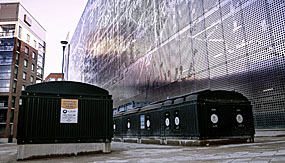
© Miro Valtonen
The City of Jyväskylä’s Circwaste sub-project develops smart waste management in the Kangas city district. The deep collection points of waste components use key tag-operated electronic locks.
“Each time a waste collection point locks opens, it is recorded in the service of the lock-provider,” explains Liaison manager Tanja Oksa from the City of Jyväskylä. Waste data has been collected for almost two years now, but the public statistics were first introduced on the Kangasverkko service in late 2020. “This service informs the residents of the number of times the waste collection points are used, the recycling rate of different waste components and an estimate of the filling capacity of the waste containers.”
When is waste deposited at collection points?
How waste collection point visits are divided between different days of the week is easily detected in the data. “We can also see how evenly the use of the five waste collection points in the area is distributed and how their use varies by components of waste,” Oksanen states.
Of the Kangasverkko waste statistics, the first item to be introduced were the daily waste container opening times by waste component this year. “The amount of waste collected appears to be quite evenly distributed across the days of the week, and often we see that all types of waste are taken to the containers at the same time,” Oksa mentions.
Actual accumulation differs from estimates
There are interesting observations among the data. In some waste components, the actual load of waste at the collection points appears to differ somewhat from the calculated accumulation rate and capacity. “There is much more cardboard than expected and a lot less paper, for example. It appears that changes in consumption have taken place at a fast pace.”
Waste data does help to monitor how changes in society or regional changes affect waste volumes. A slight increase was seen in mixed waste visits in the spring, which is explained by the completion of 185 new apartments in the area and the coronavirus outbreak,” Oksa mentions. “People spent more time at home than usual and there was additional accumulation of protective gear waste produced at the senior assisted living unit in the district.”
Oksa sees plastic packaging as one of the most interesting components of waste. Their collection in each property began in the beginning of the year. “We are looking forward to the January and February data of the plastic collection points’ user rates and their impact on the collection volumes of mixed waste.”
Waste data collection takes a lot of work in practice
The idea of the electronic waste data service is simple, but the practical tests have shown that it is not easy to develop an easy-to-use service for residents.
“Questions that remain to be solved include things like data system compatibility and questions relevant to the visuality of information. The data must be presented clearly for the residents to find it exciting,” Oksa states. Data anonymisation and security are equally important. “The project does not monitor single key tags and the visits to the waste containers cannot be associated with a certain apartment.”
Attention has also been paid to ensuring the correctness of data. A certain waste collection point might not be used and waste data remains uncollected if a lock is not working. “Servicing over 40 electronic lock systems and managing the entire service chain requires regular control visits,” Oksa states.
Development ideas for the future
The waste data project in Kangas will last until the end of September. Before this, it will be assessed if the project should continue and in which form. Positive feedback from residents speaks in favour of an extension. “Before the locks were introduced, we got a lot of feedback about how cumbersome they would be. But there has been no critical feedback whatsoever since they have been in use!” Oksa comments with content.
Many interesting questions do remain unanswered. “We have looked into surveillance camera technology, but it is not, at least not yet, reliable enough to provide assessments on the size of the disposed rubbish bag and, with that, waste volumes. There are often blind spots or the image quality is poor in other ways.”
At least one thesis project will be completed in the Kangas area during the last year of the project. “Right now, we are searching for volunteers for a gamified test project, where a system of points is used to monitor the residents’ mixed waste collection,” Oksa explains. “This will also allow us to compare the mixed waste collected by the volunteers and its accumulation in the area as a whole.”
Read more